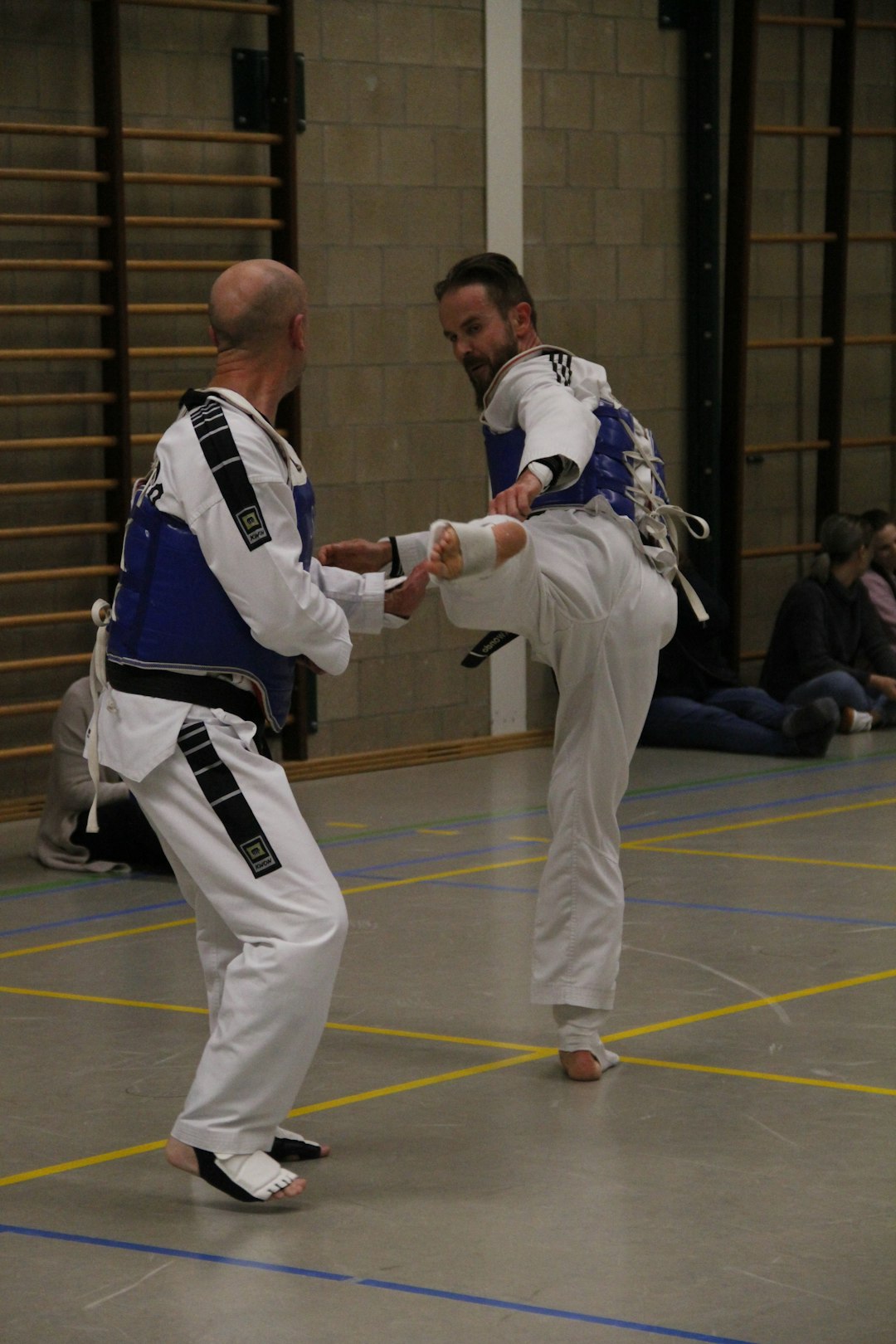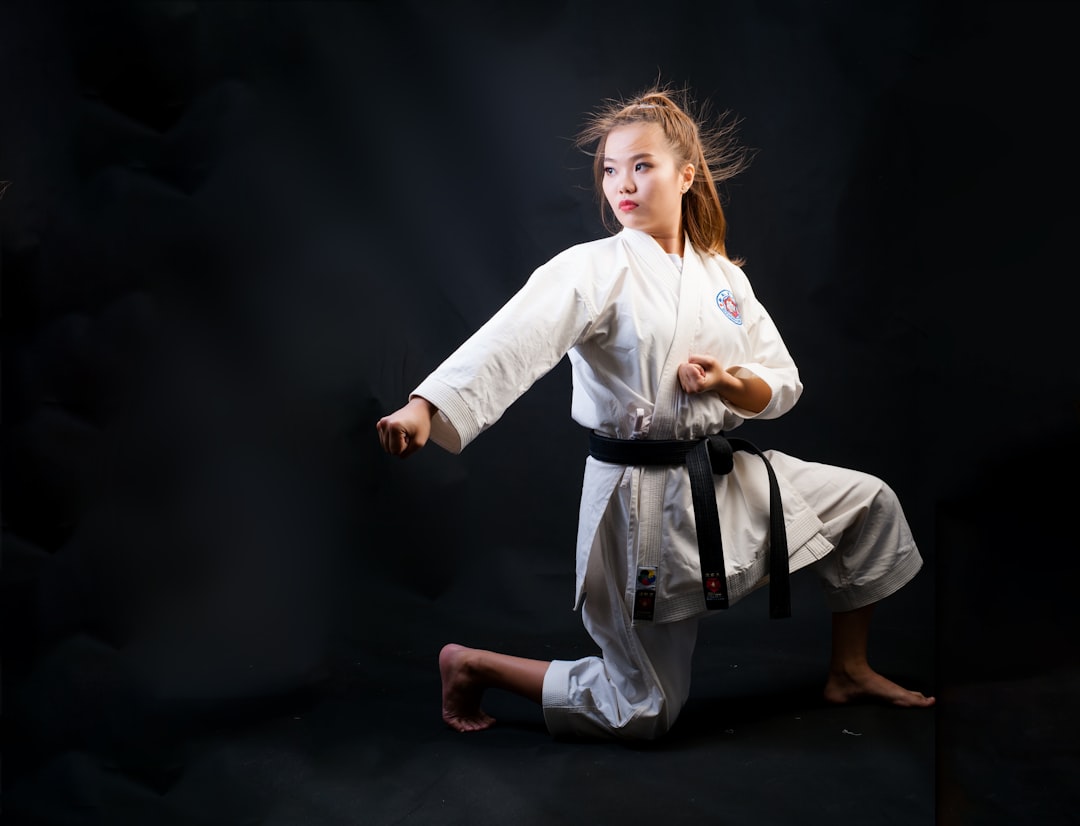Karate uniforms, known as keikogi or gi, are integral to the practice of karate, serving both functional and symbolic purposes. These garments are typically made from heavyweight cotton or hemp to facilitate a practitioner's range of motion during techniques, with the fabric's choice being crucial for breathability and durability. The white color of the gi signifies purity and humility, while the uniform's design—including the jacket's lack of waist seam and the trousers' loose fit—ensures unrestricted movement. The obi, or belt, around the waist not only holds the gi together but also indicates the wearer's rank, reflecting their commitment to the discipline and its traditions. Karate practitioners should select a gi that balances comfort with resilience, with a fit that allows for full motion and accurately represents their rank. The choice between traditional white and other colored gis for higher belts signifies experience and skill within the karate community. In essence, the keikogi upholds the martial art's heritage while supporting the physical demands of practice, making it a pivotal element in the authentic karate experience.
Karate enthusiasts and practitioners understand that a karate uniform, or ‘Gi’, is more than mere attire; it’s a symbol of tradition and respect for the martial art. This article delves into the essence of karate uniforms called Gi, exploring their significance, composition, and evolution across various schools of karate. From the fibers that constitute them to the styles that differentiate them, we will guide you through selecting the right Gi for peak performance in your training. Join us as we unfold the importance of these garments within the discipline of karate.
- Understanding the Significance of Karate Uniforms Called Gi
- The Composition and Characteristics of Traditional Karate Gis
- Evolving Styles: Variations of Karate Uniforms Across Different Schools
- Selecting the Right Gi for Optimal Performance in Karate Training
Understanding the Significance of Karate Uniforms Called Gi

Karate practitioners adorn themselves in attire that is steeped in tradition and functional design, known colloquially as karate uniforms called ‘gi’. These garments are not merely a formality; they serve a significant purpose in the practice of martial arts. The ‘gi’ is constructed with a heavyweight cotton or hemp fabric, which facilitates ease of movement and allows for a full range of motion during techniques. Does the material of the gi impact the practitioner’s ability to execute moves? Absolutely; the traditional uniform is tailored to be durable and breathable, ensuring that the karateka can move fluidly without restriction. Additionally, the ‘gi’ is designed with a belt, or obi, which signifies the wearer’s rank within the discipline. Is the design of the gi symbolic? Indeed, each element of the uniform, from the jacket to the pants and the belt, carries meaning and represents different aspects of karate’s philosophy and structure. Understanding the significance of these elements enhances not only a practitioner’s technique but also their respect for the art form and its traditions.
The Composition and Characteristics of Traditional Karate Gis

Karate practitioners are adorned in distinctive attire known colloquially as “karate uniforms,” often referred to by their traditional Japanese name, “keikogi” or “gi.” These garments are not merely a uniform but a symbol of respect and discipline within the martial arts community. A traditional karate gi typically consists of a jacket and trousers made from heavy cotton or hemp fabric, designed to facilitate freedom of movement while withstanding the rigors of practice. The jacket, or “uwagi,” features a belt, known as an “obi,” which not only holds the garment in place but also signifies the wearer’s rank within the discipline. The trousers, called “bakama” or “dogi,” may be plain or feature pleats and are intended to be loose-fitting for ease of movement. The gi’s design is both practical and symbolic; its white color represents purity and readiness, while the simple lines reflect the simplicity and discipline of karate practice.
The characteristics of a traditional karate gi extend beyond its composition and color; it also follows a specific sizing and cut that differs from conventional clothing. The jacket is cut straight with no waist seam to allow for a full range of motion during techniques such as blocks, punches, and kicks. The trousers, while also allowing for movement, are tailored to fit comfortably without being too tight. Additionally, the length of both the jacket and trousers is standardized so that all practitioners, regardless of stature, can wear the gi with a similar silhouette during practice and competition. This standardization reinforces the sense of unity among karateka, or students of karate, and emphasizes the focus on skill and technique rather than personal distinctions.
Evolving Styles: Variations of Karate Uniforms Across Different Schools

Karate uniforms, often referred to as “keikogi” in Japanese, serve as more than mere attire for practitioners; they represent tradition and discipline within the martial arts community. The evolution of karate uniforms across different schools reflects a blend of cultural influences and functional design elements. For instance, the traditional keikogi typically consists of a jacket and trousers made of cotton or hemp, featuring white as the predominant color, symbolizing purity and humility. However, the specific style can vary between schools; some may incorporate belted designs, while others maintain a simpler, more streamlined look. What distinguishes the karate uniforms called “keikogi” across different schools is not only the fabric or the cut but also the regional variations in design that have emerged over time, each reflecting the unique philosophy and practice of its respective school’s karate style. Are the differences in these uniforms purely aesthetic, or do they signify something deeper about the discipline and the lineage of karate practitioners? The answer lies in both tradition and practicality: while some schools adhere strictly to historical patterns, others have adapted their uniforms for functionality and comfort, ensuring that the garments do not impede the movements of the martial artists during practice or competition. This adaptation highlights the dynamic nature of karate as a discipline and the ongoing evolution of its associated attire.
Selecting the Right Gi for Optimal Performance in Karate Training

When it comes to selecting the right karate uniform, also known as a gi, for optimal performance in karate training, there are several factors to consider. The material of the gi is crucial; it should be lightweight yet durable enough to withstand the rigors of practice and competition. Is the fabric breathable? A quality gi made from a blend of cotton and polyester can provide the right balance of comfort and resilience, ensuring that practitioners remain cool and dry during intense sessions while maintaining the structural integrity of the garment. Additionally, the fit of the gi is equally important; it should not be too tight or too loose. A well-fitted gi allows for a full range of motion, enabling karateka to execute techniques with precision and ease. Does the gi allow for flexibility in your movements without being overly restrictive? A correctly sized gi can make a significant difference in both training efficiency and comfort, ultimately enhancing the karate practitioner’s performance.
Furthermore, the color of the gi often reflects the wearer’s rank within the discipline. Beginners usually start with white gis, which symbolize purity and innocence. As one advances, they may choose different colors that represent higher belts and levels of expertise. What color gi aligns with your current belt level? Making sure your gi accurately represents your status is a sign of respect for tradition and an acknowledgment of your journey in karate. In addition to color, the style of the gi can also vary; traditional gis have no collar, while some modern versions include one. Which style suits your needs and preferences? Considering these aspects will help you select a gi that not only adheres to the traditional practices of karate but also supports your personal performance objectives.
In conclusion, the karate uniform, or gi, serves as a cornerstone of tradition and functionality within the practice of karate. Its significance extends beyond mere attire, symbolizing respect for the discipline, instructors, and fellow practitioners. Whether one is engaging in Shotokan, Kyokushin, or any other style, understanding the composition and characteristics of traditional karate gis provides insight into what makes them suitable for this martial art. With variations across different schools, the right gi becomes a personal selection that balances adherence to tradition with modern needs for performance and comfort. Ultimately, whether for practice or competition, the choice of a karate uniform is a deliberate one that reflects both the individual’s respect for the art and their commitment to its principles.
